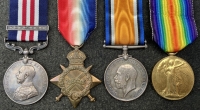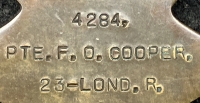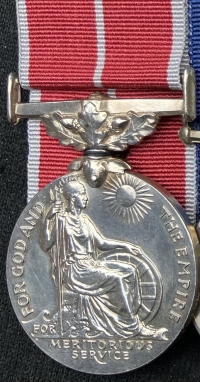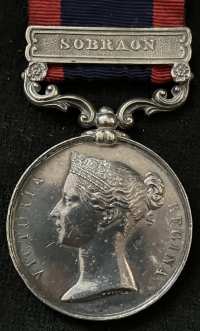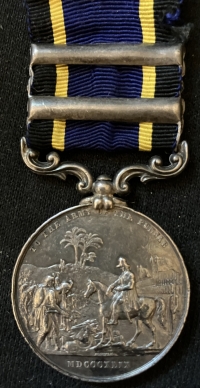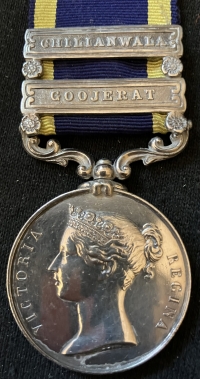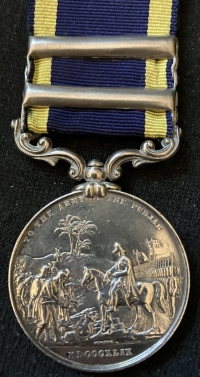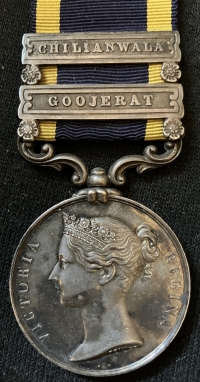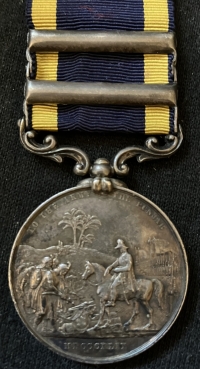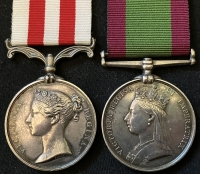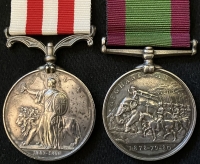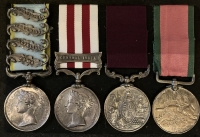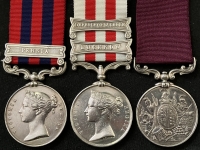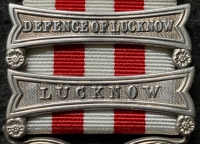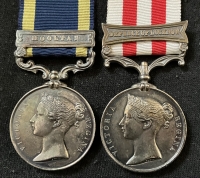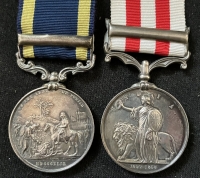An Extremely Rare and Enigmatic
“Intelligence Corps”(Special Agent’s)
MILITARY CROSS
&
1914-15 Star Trio
M.I.D. (Twice)
& Commemorative Plaque.
To.
2nd Lt HENRY MAITLAND-MAITLAND
Died of lobar pneumonia via Spanish Flu
on the penultimate day of the war.
Died 10th NOVEMBER 1918 at Cherbourg.



 [THE MEDALS]
Military Cross
(London Gazette, 1st January 1919)
“Special List attd: Intelligence Corps”
Housed in Original Case.
CAPTAIN H.M.MAITLAND
INTELLIGENCE CORPS
Contemporary Private Chisel Engraving in Block Capitals.
[THE MEDALS]
Military Cross
(London Gazette, 1st January 1919)
“Special List attd: Intelligence Corps”
Housed in Original Case.
CAPTAIN H.M.MAITLAND
INTELLIGENCE CORPS
Contemporary Private Chisel Engraving in Block Capitals.
 1914-1915 Star
2. LIEUT. H.M. MAITLAND
1914-1915 Star
2. LIEUT. H.M. MAITLAND
 War & Victory Medal (with MID emblem)
CAPT. H.M. MAITLAND
(All medals are practically “Mint State” with superbly toned original and uncleaned surfaces, and with mint unused WW1 silk ribbons.)
War & Victory Medal (with MID emblem)
CAPT. H.M. MAITLAND
(All medals are practically “Mint State” with superbly toned original and uncleaned surfaces, and with mint unused WW1 silk ribbons.)
 [THE PLAQUE]
“HENRY MAITLAND MAITLAND”
A Superb Mint State Example & As Cast.
Interestingly, none of his three “service medals” give the slightest clue as to which branch of the services Henry belonged to as they carry ‘name and rank only”
[BIOGRAPHY] c, 1885 - 10th November 1918.
Henry Maitland-Maitland was born about 1885 and was the second son of Margaretta & Arthur Maitland J.P. a barrister of Shudy Camps Park, Cambridgeshire.
His elder brother, was Edward Maitland-Maitland (Brigadier-General, later Air Commodore E.M. MAITLAND, CMG, DSO, AFC) who was killed while serving in the RAF in the infamous R34 airship crash in 1921.
Henry was educated at Marlborough School and Selwyn College, Cambridge and later at Trinity College, Cambridge.
[THE PLAQUE]
“HENRY MAITLAND MAITLAND”
A Superb Mint State Example & As Cast.
Interestingly, none of his three “service medals” give the slightest clue as to which branch of the services Henry belonged to as they carry ‘name and rank only”
[BIOGRAPHY] c, 1885 - 10th November 1918.
Henry Maitland-Maitland was born about 1885 and was the second son of Margaretta & Arthur Maitland J.P. a barrister of Shudy Camps Park, Cambridgeshire.
His elder brother, was Edward Maitland-Maitland (Brigadier-General, later Air Commodore E.M. MAITLAND, CMG, DSO, AFC) who was killed while serving in the RAF in the infamous R34 airship crash in 1921.
Henry was educated at Marlborough School and Selwyn College, Cambridge and later at Trinity College, Cambridge.
 [AN EARLY STARTER IN AVIATION]
In about 1910 at about the age of 25, Henry clearly wished to follow in his elder brother’s footsteps when he took up flying training.
He was one of the first pupils to learn to fly at the Larkhill, Salisbury Plain school of the British & Colonial Aeroplane Company under the instruction of
[AN EARLY STARTER IN AVIATION]
In about 1910 at about the age of 25, Henry clearly wished to follow in his elder brother’s footsteps when he took up flying training.
He was one of the first pupils to learn to fly at the Larkhill, Salisbury Plain school of the British & Colonial Aeroplane Company under the instruction of
 M. Henri Jullerot. (Pictured left) He will have trained on one of the school’s three Bristol Boxkites.
The BCAC at Larkhill on Salisbury Plain started in June 1910, when the school was established on 2,248 acres of land leased from the War Office . This early flying school came to be regarded as one of the best in the world, and by 1914, 308 of the 664 Royal Aero Club certificates which had been issued had been gained at the company's schools. Most of the other certificates being earned at the famous Tommy Sopwith School of Aviation at Brooklands.
Sadly, Henry’s flying career came to a premature close following a serious crash in a Bristol biplane in which he broke both his legs and suffered other injuries.
He also apparently took part in some early ballon training in connection with the then revolutionary field of airborne surveillance and radio communication.
M. Henri Jullerot. (Pictured left) He will have trained on one of the school’s three Bristol Boxkites.
The BCAC at Larkhill on Salisbury Plain started in June 1910, when the school was established on 2,248 acres of land leased from the War Office . This early flying school came to be regarded as one of the best in the world, and by 1914, 308 of the 664 Royal Aero Club certificates which had been issued had been gained at the company's schools. Most of the other certificates being earned at the famous Tommy Sopwith School of Aviation at Brooklands.
Sadly, Henry’s flying career came to a premature close following a serious crash in a Bristol biplane in which he broke both his legs and suffered other injuries.
He also apparently took part in some early ballon training in connection with the then revolutionary field of airborne surveillance and radio communication.
 Had he not sustained the serious flying injuries during his training, it’s looking like he would have become a well known aviator or a famous individual in the Royal Flying Corps, as many of these early aviators certainly did.
[THE GREAT WAR] 1914-18
-The Intelligence Corps-
Henry was on business in South America at the outbreak of The Great War and immediately returned to the U.K. He first joined the Army Motor Cycle Corps in August 1914, but when it was found he was a fluent French Speaker he was immediately transferred to the newly thrown together Intelligence Corps on 3rd November 1914 and duly shipped out to France.
He arrived in France with the BEF as a Lieutenant on 9th December 1914.
Had he not sustained the serious flying injuries during his training, it’s looking like he would have become a well known aviator or a famous individual in the Royal Flying Corps, as many of these early aviators certainly did.
[THE GREAT WAR] 1914-18
-The Intelligence Corps-
Henry was on business in South America at the outbreak of The Great War and immediately returned to the U.K. He first joined the Army Motor Cycle Corps in August 1914, but when it was found he was a fluent French Speaker he was immediately transferred to the newly thrown together Intelligence Corps on 3rd November 1914 and duly shipped out to France.
He arrived in France with the BEF as a Lieutenant on 9th December 1914.
 Little is known of his obviously clandestine activities during the period late 1914 to mid 1916, but it’s thought the period was taken up with specialist training & familiarisation with the business of Military shipping security & connected circumstances surrounding enemy infiltration of the docking areas around Dunkirk & later Cherbourg.
It was well known that German & enemy spies were attempting to obtain important information on the details of weapons & arms being shipped into France from the United Kingdom, and were gathering intelligence on the scale & disposition of allied shipping etc.
On 15th May 1916 he’s seen being appointed as “AGENT 2nd CLASS”
and 15 months later with a promotion ‘in the field’ on 2nd August 1917 as “AGENT 1st CLASS, ....whilst holding a “Special Appointment” !
Little is known of his obviously clandestine activities during the period late 1914 to mid 1916, but it’s thought the period was taken up with specialist training & familiarisation with the business of Military shipping security & connected circumstances surrounding enemy infiltration of the docking areas around Dunkirk & later Cherbourg.
It was well known that German & enemy spies were attempting to obtain important information on the details of weapons & arms being shipped into France from the United Kingdom, and were gathering intelligence on the scale & disposition of allied shipping etc.
On 15th May 1916 he’s seen being appointed as “AGENT 2nd CLASS”
and 15 months later with a promotion ‘in the field’ on 2nd August 1917 as “AGENT 1st CLASS, ....whilst holding a “Special Appointment” !
 He’s then seen being twice mentioned in two dispatches by General Sir Douglas Haigh in 1917 & 1918 while working under clandestine circumstances, almost certainly in plain clothes, at the ports of Dunkirk and Cherbourg, with more service in Rouen.
He is seen on a 2 days extended leave period in the U.K. on 21st August 1918 prior to a return to France where he clearly became infected by the then pandemic Spanish Flu.
On 5th November 1918 he’s seen being admitted to No.1 Rest Camp at Tourlaville, near Cherbourg suffering from Pneumonia.
He’s then seen being twice mentioned in two dispatches by General Sir Douglas Haigh in 1917 & 1918 while working under clandestine circumstances, almost certainly in plain clothes, at the ports of Dunkirk and Cherbourg, with more service in Rouen.
He is seen on a 2 days extended leave period in the U.K. on 21st August 1918 prior to a return to France where he clearly became infected by the then pandemic Spanish Flu.
On 5th November 1918 he’s seen being admitted to No.1 Rest Camp at Tourlaville, near Cherbourg suffering from Pneumonia.
 He sadly died of Lobar Pneumonia five days later on 10th November 1918.......this was less than 24 hours prior to the cessation of hostilities when The Great War ended the next day at 11:00am on 11th November 1918.
He is buried & commemorated with eternal honour at Tourlaville Cemetery, near Cherbourg, France.
Henry M. Maitland was a regular contributor to the well known WW1 Army magazine called, “The Bystander” where his articles appeared under the name of “Jack Johnson”. He was also the author of “Lighter Than Air” and other humorous stories.
[Intelligence Corps History, Boer War 1899-1901 & WW1 1914-1918]
Prior to the Boer War (1899-1901) the British Army formed ad-hoc intelligence organisations that were disbanded during peace time. The need to collect, analyse and interpret large amounts of information during the Boer War led to the creation of an intelligence element of over 2000 members. After the war, Intelligence continued to be underfunded with only a small counter intelligence department formed in 1909 (now MI5) and a second small department formed in 1912 for gathering military intelligence overseas (now MI6).
He sadly died of Lobar Pneumonia five days later on 10th November 1918.......this was less than 24 hours prior to the cessation of hostilities when The Great War ended the next day at 11:00am on 11th November 1918.
He is buried & commemorated with eternal honour at Tourlaville Cemetery, near Cherbourg, France.
Henry M. Maitland was a regular contributor to the well known WW1 Army magazine called, “The Bystander” where his articles appeared under the name of “Jack Johnson”. He was also the author of “Lighter Than Air” and other humorous stories.
[Intelligence Corps History, Boer War 1899-1901 & WW1 1914-1918]
Prior to the Boer War (1899-1901) the British Army formed ad-hoc intelligence organisations that were disbanded during peace time. The need to collect, analyse and interpret large amounts of information during the Boer War led to the creation of an intelligence element of over 2000 members. After the war, Intelligence continued to be underfunded with only a small counter intelligence department formed in 1909 (now MI5) and a second small department formed in 1912 for gathering military intelligence overseas (now MI6).
 Although the first proposals to create a full time Army intelligence corps came in 1905, the first Intelligence Corps was actually only formed on 5th August 1914 (the day after the declaration of war) and originally included Army Officers, Metropolitan Police Officers and “useful specialist civilians” identified by the War Office Intelligence Department which included fluent foreign language speakers, most of whom were put into Army uniform.
This slightly “Heath-Robinson” group hurriedly left for France on 12 August 1914.[
The members of the new corps operated in all theatres of war and on some occasions operated clandestinely behind enemy lines in civilian clothes.
The R.F.C. was originally formed to monitor the ground movements & positions of the enemy and it provided aerial photographs for the Intelligence Corps to analyse.
During the Irish War of Independence Intelligence Corps operatives were used to monitor the IRA. Following the war the Intelligence Corps was gradually scaled down and despite its success, the Corps was disbanded entirely in 1929 with any intelligence matters being left to individual unit officers.
Although the first proposals to create a full time Army intelligence corps came in 1905, the first Intelligence Corps was actually only formed on 5th August 1914 (the day after the declaration of war) and originally included Army Officers, Metropolitan Police Officers and “useful specialist civilians” identified by the War Office Intelligence Department which included fluent foreign language speakers, most of whom were put into Army uniform.
This slightly “Heath-Robinson” group hurriedly left for France on 12 August 1914.[
The members of the new corps operated in all theatres of war and on some occasions operated clandestinely behind enemy lines in civilian clothes.
The R.F.C. was originally formed to monitor the ground movements & positions of the enemy and it provided aerial photographs for the Intelligence Corps to analyse.
During the Irish War of Independence Intelligence Corps operatives were used to monitor the IRA. Following the war the Intelligence Corps was gradually scaled down and despite its success, the Corps was disbanded entirely in 1929 with any intelligence matters being left to individual unit officers.
 This is a really exceptional Military Cross gallantry group to a man who took a small part in the dawn of British aviation, and due to fate’s hand went on to become one of the United Kingdom’s leading Military Special Agents of WW1.
He was indeed also at the dawn of our full time Army Military Intelligence Department which has since become the famous MI6.
By the time of his untimely death in 1918, Captan Henry Maitland was a very well known, decorated, twice mentioned and highly experienced individual in security matters in France. Had he lived to continue his work as an Intelligence officer in World War 2, and at the age of about only 50 he may well have been a pivotal & senior figure in the initial formation of S.O.E. (Special Operations Executive).
He was just the type of chap Churchill was looking for......
.............to “Set Europe Ablaze”
It seems that his life’s journey was twice foiled by fate & tragic circumstance.
IN THE WORDS OF Captain JACK AUBREY (In The Film, Master & Commander)
“The simple truth is, not all of us become the men we once hoped we might be”
The group comes with an excellent file of research papers.
This is a really exceptional Military Cross gallantry group to a man who took a small part in the dawn of British aviation, and due to fate’s hand went on to become one of the United Kingdom’s leading Military Special Agents of WW1.
He was indeed also at the dawn of our full time Army Military Intelligence Department which has since become the famous MI6.
By the time of his untimely death in 1918, Captan Henry Maitland was a very well known, decorated, twice mentioned and highly experienced individual in security matters in France. Had he lived to continue his work as an Intelligence officer in World War 2, and at the age of about only 50 he may well have been a pivotal & senior figure in the initial formation of S.O.E. (Special Operations Executive).
He was just the type of chap Churchill was looking for......
.............to “Set Europe Ablaze”
It seems that his life’s journey was twice foiled by fate & tragic circumstance.
IN THE WORDS OF Captain JACK AUBREY (In The Film, Master & Commander)
“The simple truth is, not all of us become the men we once hoped we might be”
The group comes with an excellent file of research papers.


 A Unique & Ultra Desirable Gallantry & Twice Mentioned group to an exceptional Army Intelligence Officer & Special Agent, the full details of who’s clandestine service in The Great War will probably never be truly known.
Excessively Rare SOLD, EXPORT
A Unique & Ultra Desirable Gallantry & Twice Mentioned group to an exceptional Army Intelligence Officer & Special Agent, the full details of who’s clandestine service in The Great War will probably never be truly known.
Excessively Rare SOLD, EXPORT



 [THE MEDALS]
Military Cross
(London Gazette, 1st January 1919)
“Special List attd: Intelligence Corps”
Housed in Original Case.
CAPTAIN H.M.MAITLAND
INTELLIGENCE CORPS
Contemporary Private Chisel Engraving in Block Capitals.
[THE MEDALS]
Military Cross
(London Gazette, 1st January 1919)
“Special List attd: Intelligence Corps”
Housed in Original Case.
CAPTAIN H.M.MAITLAND
INTELLIGENCE CORPS
Contemporary Private Chisel Engraving in Block Capitals.
 1914-1915 Star
2. LIEUT. H.M. MAITLAND
1914-1915 Star
2. LIEUT. H.M. MAITLAND
 War & Victory Medal (with MID emblem)
CAPT. H.M. MAITLAND
(All medals are practically “Mint State” with superbly toned original and uncleaned surfaces, and with mint unused WW1 silk ribbons.)
War & Victory Medal (with MID emblem)
CAPT. H.M. MAITLAND
(All medals are practically “Mint State” with superbly toned original and uncleaned surfaces, and with mint unused WW1 silk ribbons.)
 [THE PLAQUE]
“HENRY MAITLAND MAITLAND”
A Superb Mint State Example & As Cast.
Interestingly, none of his three “service medals” give the slightest clue as to which branch of the services Henry belonged to as they carry ‘name and rank only”
[BIOGRAPHY] c, 1885 - 10th November 1918.
Henry Maitland-Maitland was born about 1885 and was the second son of Margaretta & Arthur Maitland J.P. a barrister of Shudy Camps Park, Cambridgeshire.
His elder brother, was Edward Maitland-Maitland (Brigadier-General, later Air Commodore E.M. MAITLAND, CMG, DSO, AFC) who was killed while serving in the RAF in the infamous R34 airship crash in 1921.
Henry was educated at Marlborough School and Selwyn College, Cambridge and later at Trinity College, Cambridge.
[THE PLAQUE]
“HENRY MAITLAND MAITLAND”
A Superb Mint State Example & As Cast.
Interestingly, none of his three “service medals” give the slightest clue as to which branch of the services Henry belonged to as they carry ‘name and rank only”
[BIOGRAPHY] c, 1885 - 10th November 1918.
Henry Maitland-Maitland was born about 1885 and was the second son of Margaretta & Arthur Maitland J.P. a barrister of Shudy Camps Park, Cambridgeshire.
His elder brother, was Edward Maitland-Maitland (Brigadier-General, later Air Commodore E.M. MAITLAND, CMG, DSO, AFC) who was killed while serving in the RAF in the infamous R34 airship crash in 1921.
Henry was educated at Marlborough School and Selwyn College, Cambridge and later at Trinity College, Cambridge.
 [AN EARLY STARTER IN AVIATION]
In about 1910 at about the age of 25, Henry clearly wished to follow in his elder brother’s footsteps when he took up flying training.
He was one of the first pupils to learn to fly at the Larkhill, Salisbury Plain school of the British & Colonial Aeroplane Company under the instruction of
[AN EARLY STARTER IN AVIATION]
In about 1910 at about the age of 25, Henry clearly wished to follow in his elder brother’s footsteps when he took up flying training.
He was one of the first pupils to learn to fly at the Larkhill, Salisbury Plain school of the British & Colonial Aeroplane Company under the instruction of
 M. Henri Jullerot. (Pictured left) He will have trained on one of the school’s three Bristol Boxkites.
The BCAC at Larkhill on Salisbury Plain started in June 1910, when the school was established on 2,248 acres of land leased from the War Office . This early flying school came to be regarded as one of the best in the world, and by 1914, 308 of the 664 Royal Aero Club certificates which had been issued had been gained at the company's schools. Most of the other certificates being earned at the famous Tommy Sopwith School of Aviation at Brooklands.
Sadly, Henry’s flying career came to a premature close following a serious crash in a Bristol biplane in which he broke both his legs and suffered other injuries.
He also apparently took part in some early ballon training in connection with the then revolutionary field of airborne surveillance and radio communication.
M. Henri Jullerot. (Pictured left) He will have trained on one of the school’s three Bristol Boxkites.
The BCAC at Larkhill on Salisbury Plain started in June 1910, when the school was established on 2,248 acres of land leased from the War Office . This early flying school came to be regarded as one of the best in the world, and by 1914, 308 of the 664 Royal Aero Club certificates which had been issued had been gained at the company's schools. Most of the other certificates being earned at the famous Tommy Sopwith School of Aviation at Brooklands.
Sadly, Henry’s flying career came to a premature close following a serious crash in a Bristol biplane in which he broke both his legs and suffered other injuries.
He also apparently took part in some early ballon training in connection with the then revolutionary field of airborne surveillance and radio communication.
 Had he not sustained the serious flying injuries during his training, it’s looking like he would have become a well known aviator or a famous individual in the Royal Flying Corps, as many of these early aviators certainly did.
[THE GREAT WAR] 1914-18
-The Intelligence Corps-
Henry was on business in South America at the outbreak of The Great War and immediately returned to the U.K. He first joined the Army Motor Cycle Corps in August 1914, but when it was found he was a fluent French Speaker he was immediately transferred to the newly thrown together Intelligence Corps on 3rd November 1914 and duly shipped out to France.
He arrived in France with the BEF as a Lieutenant on 9th December 1914.
Had he not sustained the serious flying injuries during his training, it’s looking like he would have become a well known aviator or a famous individual in the Royal Flying Corps, as many of these early aviators certainly did.
[THE GREAT WAR] 1914-18
-The Intelligence Corps-
Henry was on business in South America at the outbreak of The Great War and immediately returned to the U.K. He first joined the Army Motor Cycle Corps in August 1914, but when it was found he was a fluent French Speaker he was immediately transferred to the newly thrown together Intelligence Corps on 3rd November 1914 and duly shipped out to France.
He arrived in France with the BEF as a Lieutenant on 9th December 1914.
 Little is known of his obviously clandestine activities during the period late 1914 to mid 1916, but it’s thought the period was taken up with specialist training & familiarisation with the business of Military shipping security & connected circumstances surrounding enemy infiltration of the docking areas around Dunkirk & later Cherbourg.
It was well known that German & enemy spies were attempting to obtain important information on the details of weapons & arms being shipped into France from the United Kingdom, and were gathering intelligence on the scale & disposition of allied shipping etc.
On 15th May 1916 he’s seen being appointed as “AGENT 2nd CLASS”
and 15 months later with a promotion ‘in the field’ on 2nd August 1917 as “AGENT 1st CLASS, ....whilst holding a “Special Appointment” !
Little is known of his obviously clandestine activities during the period late 1914 to mid 1916, but it’s thought the period was taken up with specialist training & familiarisation with the business of Military shipping security & connected circumstances surrounding enemy infiltration of the docking areas around Dunkirk & later Cherbourg.
It was well known that German & enemy spies were attempting to obtain important information on the details of weapons & arms being shipped into France from the United Kingdom, and were gathering intelligence on the scale & disposition of allied shipping etc.
On 15th May 1916 he’s seen being appointed as “AGENT 2nd CLASS”
and 15 months later with a promotion ‘in the field’ on 2nd August 1917 as “AGENT 1st CLASS, ....whilst holding a “Special Appointment” !
 He’s then seen being twice mentioned in two dispatches by General Sir Douglas Haigh in 1917 & 1918 while working under clandestine circumstances, almost certainly in plain clothes, at the ports of Dunkirk and Cherbourg, with more service in Rouen.
He is seen on a 2 days extended leave period in the U.K. on 21st August 1918 prior to a return to France where he clearly became infected by the then pandemic Spanish Flu.
On 5th November 1918 he’s seen being admitted to No.1 Rest Camp at Tourlaville, near Cherbourg suffering from Pneumonia.
He’s then seen being twice mentioned in two dispatches by General Sir Douglas Haigh in 1917 & 1918 while working under clandestine circumstances, almost certainly in plain clothes, at the ports of Dunkirk and Cherbourg, with more service in Rouen.
He is seen on a 2 days extended leave period in the U.K. on 21st August 1918 prior to a return to France where he clearly became infected by the then pandemic Spanish Flu.
On 5th November 1918 he’s seen being admitted to No.1 Rest Camp at Tourlaville, near Cherbourg suffering from Pneumonia.
 He sadly died of Lobar Pneumonia five days later on 10th November 1918.......this was less than 24 hours prior to the cessation of hostilities when The Great War ended the next day at 11:00am on 11th November 1918.
He is buried & commemorated with eternal honour at Tourlaville Cemetery, near Cherbourg, France.
Henry M. Maitland was a regular contributor to the well known WW1 Army magazine called, “The Bystander” where his articles appeared under the name of “Jack Johnson”. He was also the author of “Lighter Than Air” and other humorous stories.
[Intelligence Corps History, Boer War 1899-1901 & WW1 1914-1918]
Prior to the Boer War (1899-1901) the British Army formed ad-hoc intelligence organisations that were disbanded during peace time. The need to collect, analyse and interpret large amounts of information during the Boer War led to the creation of an intelligence element of over 2000 members. After the war, Intelligence continued to be underfunded with only a small counter intelligence department formed in 1909 (now MI5) and a second small department formed in 1912 for gathering military intelligence overseas (now MI6).
He sadly died of Lobar Pneumonia five days later on 10th November 1918.......this was less than 24 hours prior to the cessation of hostilities when The Great War ended the next day at 11:00am on 11th November 1918.
He is buried & commemorated with eternal honour at Tourlaville Cemetery, near Cherbourg, France.
Henry M. Maitland was a regular contributor to the well known WW1 Army magazine called, “The Bystander” where his articles appeared under the name of “Jack Johnson”. He was also the author of “Lighter Than Air” and other humorous stories.
[Intelligence Corps History, Boer War 1899-1901 & WW1 1914-1918]
Prior to the Boer War (1899-1901) the British Army formed ad-hoc intelligence organisations that were disbanded during peace time. The need to collect, analyse and interpret large amounts of information during the Boer War led to the creation of an intelligence element of over 2000 members. After the war, Intelligence continued to be underfunded with only a small counter intelligence department formed in 1909 (now MI5) and a second small department formed in 1912 for gathering military intelligence overseas (now MI6).
 Although the first proposals to create a full time Army intelligence corps came in 1905, the first Intelligence Corps was actually only formed on 5th August 1914 (the day after the declaration of war) and originally included Army Officers, Metropolitan Police Officers and “useful specialist civilians” identified by the War Office Intelligence Department which included fluent foreign language speakers, most of whom were put into Army uniform.
This slightly “Heath-Robinson” group hurriedly left for France on 12 August 1914.[
The members of the new corps operated in all theatres of war and on some occasions operated clandestinely behind enemy lines in civilian clothes.
The R.F.C. was originally formed to monitor the ground movements & positions of the enemy and it provided aerial photographs for the Intelligence Corps to analyse.
During the Irish War of Independence Intelligence Corps operatives were used to monitor the IRA. Following the war the Intelligence Corps was gradually scaled down and despite its success, the Corps was disbanded entirely in 1929 with any intelligence matters being left to individual unit officers.
Although the first proposals to create a full time Army intelligence corps came in 1905, the first Intelligence Corps was actually only formed on 5th August 1914 (the day after the declaration of war) and originally included Army Officers, Metropolitan Police Officers and “useful specialist civilians” identified by the War Office Intelligence Department which included fluent foreign language speakers, most of whom were put into Army uniform.
This slightly “Heath-Robinson” group hurriedly left for France on 12 August 1914.[
The members of the new corps operated in all theatres of war and on some occasions operated clandestinely behind enemy lines in civilian clothes.
The R.F.C. was originally formed to monitor the ground movements & positions of the enemy and it provided aerial photographs for the Intelligence Corps to analyse.
During the Irish War of Independence Intelligence Corps operatives were used to monitor the IRA. Following the war the Intelligence Corps was gradually scaled down and despite its success, the Corps was disbanded entirely in 1929 with any intelligence matters being left to individual unit officers.
 This is a really exceptional Military Cross gallantry group to a man who took a small part in the dawn of British aviation, and due to fate’s hand went on to become one of the United Kingdom’s leading Military Special Agents of WW1.
He was indeed also at the dawn of our full time Army Military Intelligence Department which has since become the famous MI6.
By the time of his untimely death in 1918, Captan Henry Maitland was a very well known, decorated, twice mentioned and highly experienced individual in security matters in France. Had he lived to continue his work as an Intelligence officer in World War 2, and at the age of about only 50 he may well have been a pivotal & senior figure in the initial formation of S.O.E. (Special Operations Executive).
He was just the type of chap Churchill was looking for......
.............to “Set Europe Ablaze”
It seems that his life’s journey was twice foiled by fate & tragic circumstance.
IN THE WORDS OF Captain JACK AUBREY (In The Film, Master & Commander)
“The simple truth is, not all of us become the men we once hoped we might be”
The group comes with an excellent file of research papers.
This is a really exceptional Military Cross gallantry group to a man who took a small part in the dawn of British aviation, and due to fate’s hand went on to become one of the United Kingdom’s leading Military Special Agents of WW1.
He was indeed also at the dawn of our full time Army Military Intelligence Department which has since become the famous MI6.
By the time of his untimely death in 1918, Captan Henry Maitland was a very well known, decorated, twice mentioned and highly experienced individual in security matters in France. Had he lived to continue his work as an Intelligence officer in World War 2, and at the age of about only 50 he may well have been a pivotal & senior figure in the initial formation of S.O.E. (Special Operations Executive).
He was just the type of chap Churchill was looking for......
.............to “Set Europe Ablaze”
It seems that his life’s journey was twice foiled by fate & tragic circumstance.
IN THE WORDS OF Captain JACK AUBREY (In The Film, Master & Commander)
“The simple truth is, not all of us become the men we once hoped we might be”
The group comes with an excellent file of research papers.


 A Unique & Ultra Desirable Gallantry & Twice Mentioned group to an exceptional Army Intelligence Officer & Special Agent, the full details of who’s clandestine service in The Great War will probably never be truly known.
Excessively Rare SOLD, EXPORT
A Unique & Ultra Desirable Gallantry & Twice Mentioned group to an exceptional Army Intelligence Officer & Special Agent, the full details of who’s clandestine service in The Great War will probably never be truly known.
Excessively Rare SOLD, EXPORT

An Excellent Somme & Cambrai “Double Gallantry” MILITARY MEDAL & BAR. 4284. L/Cpl F.O. COOPER 1/23 London Regt. All medals Superb Mint State.
£2450
An Excellent Somme & Cambrai “Double Gallantry” MILITARY MEDAL & BAR. 4284. L/Cpl F.O. COOPER 1/23 London Regt. All medals Superb Mint State.

An Outstanding & Unique Royal Navy “South Atlantic” Group of Five.
British Empire Medal, South Atlantic Medal, Golden Jubilee Medal 2002, Meritorious Service Medal (QEII), L.S.G.C & Bar.
£4995
An Outstanding & Unique Royal Navy “South Atlantic” Group of Five. British Empire Medal, South Atlantic Medal, Golden Jubilee Medal 2002, Meritorious Service Medal (QEII), L.S.G.C & Bar.

A Rare & Desirable “CHARGE of ALIWAL” Sutlej Medal.
SOBRAON Clasp & ALIWAL Reverse. To: WILLIAM PARRY 16th LANCERS.
£1250
A Rare & Desirable “CHARGE of ALIWAL” Sutlej Medal. SOBRAON Clasp & ALIWAL Reverse. To: WILLIAM PARRY 16th LANCERS.

A Scarce & Desirable PUNJAB MEDAL 1849. (GOOJERAT)-(MOOLTAN) To. SEPOY BUGLER, PATTUCK. 3rd Native Infantry.
£595
A Scarce & Desirable PUNJAB MEDAL 1849. (GOOJERAT)-(MOOLTAN) To. SEPOY BUGLER, PATTUCK. 3rd Native Infantry.

A Very Desirable & High Grade PUNJAB MEDAL 1849. (GOOJERAT)-(CHILIANWALA). To. B. GOODCHILD. 24th Foot Regt. With confirming medal roll.
£895
A Very Desirable & High Grade PUNJAB MEDAL 1849. (GOOJERAT)-(CHILIANWALA). To. B. GOODCHILD. 24th Foot Regt. With confirming medal roll.

A Very Desirable PUNJAB MEDAL 1849. (GOOJERAT)-(CHILIANWALA) To. Sgt. F. BRITTAIN. 24th Foot Regt. Who Died of Disease, 26th August 1850.
With confirming medal roll.
£995
A Very Desirable PUNJAB MEDAL 1849. (GOOJERAT)-(CHILIANWALA) To. Sgt. F. BRITTAIN. 24th Foot Regt. Who Died of Disease, 26th August 1850. With confirming medal roll.

A Fine High Ranking Officer’s INDIAN MUTINY & AFGHANISTAN Pair.
To: LIEUT - Lt COL. (Later Major General) CHARLES HENRY CLAY.
21st & 30th Bombay Native Infantry, late Bombay Staff Corps.
£1550
A Fine High Ranking Officer’s INDIAN MUTINY & AFGHANISTAN Pair. To: LIEUT - Lt COL. (Later Major General) CHARLES HENRY CLAY. 21st & 30th Bombay Native Infantry, late Bombay Staff Corps.

A Classic “Light Brigade Charger” group of four. Crimea Medal (Four Clasps) Indian Mutiny Medal (Central India) LSGC, & Turkish Crimea (British Issue) Sgt & Farrier Major, John Dyer, 8th Hussars. Charged, 25th October 1854
£PRICE ON REQUEST (By Telephone Only)
A Classic “Light Brigade Charger” group of four. Crimea Medal (Four Clasps) Indian Mutiny Medal (Central India) LSGC, & Turkish Crimea (British Issue) Sgt & Farrier Major, John Dyer, 8th Hussars. Charged, 25th October 1854

An Ultra Rare Victorian Trio. I.G.S. (PERSIA) & Indian Mutiny (DEFENCE OF LUCKNOW)-(LUCKNOW) L.S.G.C. Q.M.Sgt. G. ILIFFE, 78th HIGHrs (2nd Seaforths) Wounded 23rd Sept 1857,At The Battle of Alambagh (LUCKNOW).
£4250
An Exceptionally Rare Victorian Combination.INDIAN GENERAL SERVICE, (PERSIA) & INDIAN MUTINY MEDALS, (DEFENCE OF LUCKNOW)-(LUCKNOW) with L.S.G.C. To: Q.M.Sgt. GEORGE ILIFFE, 78th HIGHLANDERS (2nd Bn Seaforth Highlanders) Wounded on 23rd September 1857, Battle of Alambagh (LUCKNOW).

An Excessively Rare, INDIAN MUTINY MEDAL, (DEFENCE OF LUCKNOW), “ORIGINAL DEFENDER”- (Battle of Chinhut Casualty) Killed in Action 30th June 1857) & PUNJAB MEDAL, (MOOLTAN), To: JOHN STEEPLES, 32nd Foot.
£PRICE ON REQUEST (By Telephone)
An Excessively Rare, INDIAN MUTINY MEDAL, (DEFENCE OF LUCKNOW), “AN ORIGINAL DEFENDER”- (A Battle of Chinhut Casualty) Killed in Action 30th June 1857) with PUNJAB MEDAL, (MOOLTAN), To: JOHN STEEPLES, 32nd Foot Regt.
